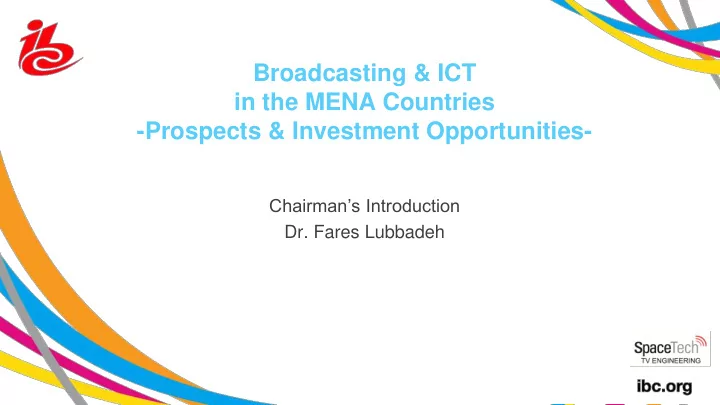

Broadcasting & ICT in the MENA Countries -Prospects & Investment Opportunities- Chairman’s Introduction Dr. Fares Lubbadeh
Statu tus s of TV Broadcasting adcasting in the Arab ab World rld In accordance with ASBU latest study, in 2012/2013, compared to 2011: • The number of broadcast organizations has increased from 608 to 776 (27.6%), of which 26 are public TV organizations and 750 are private. • The number of satellite TV Channels has increased from 1069 to 1320 (23.5% ). • The number of public channels has increased from 109 to 168 (54% increase), mainly due to the increase of sports channels from 18 to 41 (227.7%)
Statu tus s of TV Broadcasting adcasting in the Arab ab World rld • The number of private TV channels has increased from 960 to 1152 (20%), due to the increase in the number of religious channels from 83 to 135 (62.6%) and lucrative channels from 157 to 210 (33.7%). • 279 channels are encrypted (29%) and 1041 channels are free to air (79%). • The number of HDTV channels has reached 103 in April 2013 with an increase of 18% from October 2012. 45 HDTV channels are pay channels, 43 public and 15 private FTA channels
Satellite tellite Channels nels Classif ssification ication Public Private Total General 67 254 321 Lucrative 0 210 210 Drama 11 140 151 Religious 11 135 146 Sports 41 84 125 Music 1 123 124 News 5 61 66
Statu tus s of TV Broadcasting adcasting in the Arab ab World rld • 121 analogue terrestrial TV channels in the MENA countries will be affected by the analogue switch-off in 2015. While Saudi Arabia and Morocco have started DVB- T transmission , 12 MENA countries plan to deploy DVB- T/T2. • Mobile TV services & IPTV are mainly provided by Telecom organizations in the Arab world. • Expanding IPTV services in the MENA countries is affected by low broadband penetration, speeds and bandwidth.
Statu tus s of TV Broadcasting adcasting in the Arab ab World rld • OTT is being deployed in the Arab world for Video-on- Demand & Broadcast Streaming Service on the Internet. • More business opportunities in the region are available with the increasing numbers of connected TVs, Smartphones & PC tablets, used also as second screens while watching TV. • 3DTV is provided by Al-Jazeera Sports, OSN, Etisalat and Du. Shipments of 3D TV sets to ME countries have reached 27.4 millions in 2012.
Satellite tellite Operator rators s in th n the MENA NA Re Region ion • Arabsat: 450 TV Ch & 4 Pay-TV networks, Badr 6; 5; 4 at 26º E, Arabsat 5A at 30.5º E & 5C at 20º E (Ka). • Nilesat: Over 700 Ch, 101; 102; AB7 & 201 at 7º W. • Noorsat: 200 TV Ch including OSN platform, provides capacities on EB2 at 25.5º E, AB4A at 7º W, AB2 at 8º W, EB4A at 40º E & IS15 at 85.15º E. • Yahsat: 49 HDTV Ch at 52.5º E. • Gulfsat: 40 TV Ch on Eutelsat 8º W.
ICT Deve evelopm lopmen ents ts in the Arab b World ld • Cellular lines increased from 126 million in 2006 to 396 million in the 1 st quarter of 2013. Cellular penetration ranges from 56.5% in Yemen to 228% in UAE. • 3G / 3.5G services are offered by 39 operators , and LTE services are commercially launched in 6 Gulf countries. • 38% of households have internet access, mostly through wireless networks. • Fixed broadband accounts have reached over 9 million in 2012.
Broadca adcasti sting ng & the Arab b Spring ing • Inspite of the Arab Spring, the numbers of TV organizations and TV channels have increased, while many political channels were terminated and others launched. • Pan-Arab news channels played an important role in the Arab Spring news coverage. • Advertising expenditure was heavily affected in the Arab Spring countries. • Jamming on satellite channels affected satellite operators covering the region.
Social cial Media ia & the Arab b Spring ing • Social media has played an important role in communication, organization, coordination and mobilization of the protesters, and in gathering and distributing information. • In answer to the question “Was the Arab Spring really a Facebook revolution”, it must be mentioned that social media was not a catalyst, the events it describes are the catalysts.
Social cial Media ia & the Arab b Spring ing • Smartphones proved to be the most important innovation for Journalism , changing the way information is collected , packaged and transferred for mas distribution. • Facebook is the most popular in the Arab World, where the number of users has reached more than 49 millions in March 2013.
Recommend
More recommend